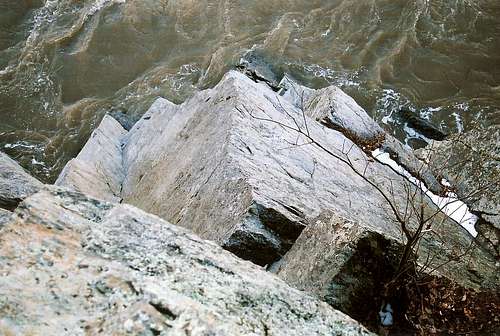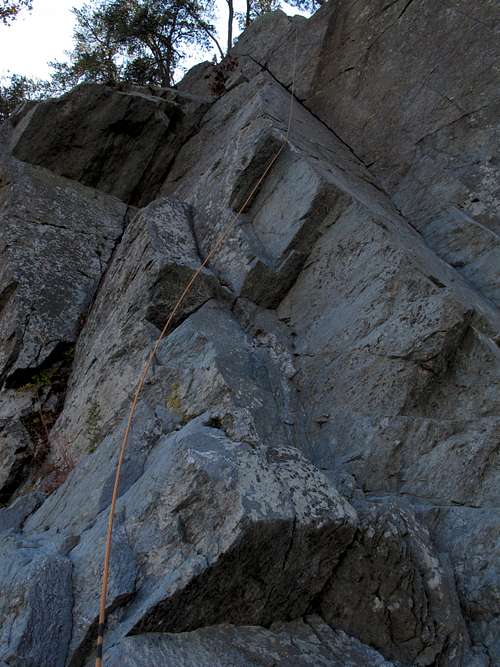-
 3293 Hits
3293 Hits
-
 77.31% Score
77.31% Score
-
 8 Votes
8 Votes
|
|
Route |
|---|---|
|
|
38.99627°N / 77.25308°W |
|
|
Trad Climbing, Toprope |
|
|
Spring, Summer, Fall, Winter |
|
|
5.5 (YDS) |
|
|
5.? |
|
|
1 |
|
|
Overview
Typically, I am not in favor of posting route pages for single-pitch routes, but this route, though in a very popular spot and right next to a very popular climb, is not in any guidebooks I own or in any online descriptions I have found. In posting this with its own route page, I am hoping the added exposure may generate some climber logs and perhaps lead to something approaching a consensus on the rating for the climb.Initially, and primarily for sorting purposes, I have listed it at 5.5. This is due to the fact that the easiest way up it feels slightly harder than the 5.4 right next to it. However, it is a different type of climb than the 5.4 is (the 5.4 is Layback Dihedral, which, as the name implies, is a dihedral involving some laybacking), so it is possible that a more experienced climber might actually find it easier than the 5.4.
Anyway, it is a fun little climb (about 50') that is easy to do off the same toprope anchor one uses for Layback Dihedral. There are also variations to it that definitely make it harder than the estimated 5.5. Something that makes this climb more challenging than it may appear to be is that like many other climbs at Great Falls, this one is on smooth, river-polished rock that is about as solid as it gets but can be very hard to get a purchase on. Floodwaters through Mather Gorge over millions of years have made so much of the rock here so slick that climbers feel the routes tend to be hard for the grade. If you are not already used to climbing at Great Falls, you should expect that your first few times at least, most routes will feel one or even two notches higher.
Although I include trad climbing (leading) as an option here, I feel toproping is a much better option. There are some opportunities to place pro lower on the route, but there is nothing good after that until near the very end, where placing pro is arguably not even necessary.
Getting There and Route Description
Locals will know their own best ways. For others, though, these directions are easiest to follow:From the western part of I-495, a piece of the Capital Beltway, take Exit 44 for Route 193, Georgetown Pike; this is the second exit south of the Maryland border. Drive west for a few miles until you see the well-signed road leading to Great Falls Park. Turn right and follow the road about a mile to the entrance station. There are two large parking lots after the entrance station.
Just past the entrance station, though, an unmarked road turns sharply right and leads to the parking area for climbers, where there is a registration box. From there, hike east to a small footbridge crossing the Patowmack Canal, cross the bridge, and hike a short distance more and finally turn right onto the River Trail.
Head down the River Trail (see Getting There). About 0.2 miles along this trail, on the left, there is an outcrop overlooking the river. This overlook is shortly after a sign indicating access to the Sandbox climbing area. On one of the rocks, there is an easy-to-spot informational plaque about Stephen Mather. This outcrop is the top of the Dihedrals area. From the plaque, you can look straight down on the Layback Dihedral route (5.4) and the arete beside it (see the picture above for a top-down view of the arete).
To access the base of the climbs, walk a few yards downstream from the plaque and look for a Class 3 way down. NOTE: Your guidebook may mention a sign indicating climbers’ access for Dihedrals; as of November 2012, that sign is no longer there. ALSO NOTE: In periods of high water, the bases of many of these climbs will be inaccessible.
To access the base of the climbs, walk a few yards downstream from the plaque and look for a Class 3 way down. NOTE: Your guidebook may mention a sign indicating climbers’ access for Dihedrals; as of November 2012, that sign is no longer there. ALSO NOTE: In periods of high water, the bases of many of these climbs will be inaccessible.
Many people simply rappel down after setting a toprope.
Climbing Options:
- From the base, take on the arete directly. This is definitely harder than 5.5 and involves super-smooth, slightly overhanging rock.
- Start up via the blocky section on the left and then move onto the arete. This, again, feels harder than 5.5 and again involves some really smooth rock, but it is not as hard as the direct start.
- Go up via the right side and gain the crest. This is easier than the direct start but harder than the second option.
Once on the crest of the arete, follow it to the top and exit left (easier) or right (harder and more exposed, and the traditional exit for Layback Dihedral).
Essential Gear
For setting up a toprope here, I have found 60' of static line more than sufficient due to sturdy trees near the edge of the cliff. Something to be careful about here is that your anchor will be within a few feet of the plaque and that multitudes of hikers stop at this spot.A 30 m rope is sufficient for the climb but not for the rappel down unless you are solo climbing and rapping on a single strand. The downside of a 60 m rope is that when you throw it down, there is a good chance the ends will end up in the river, and "snaking" it down runs the risk of it getting caught somewhere before the bottom.



